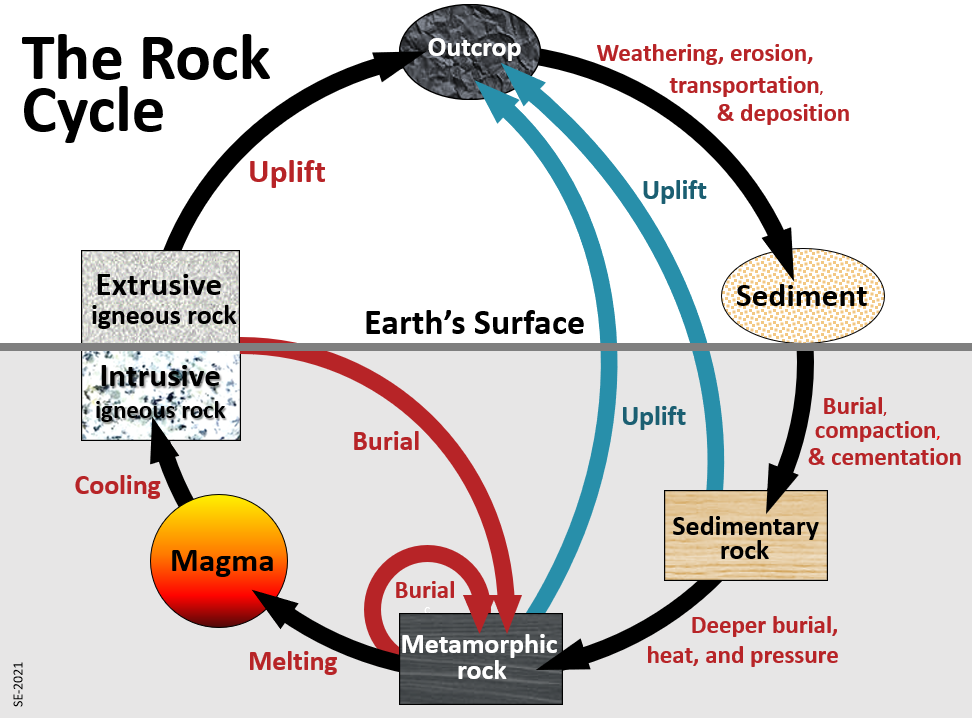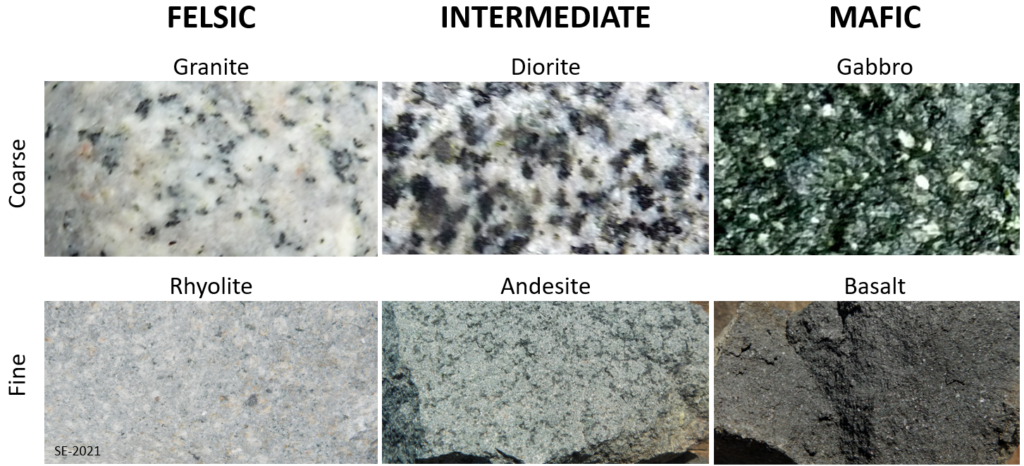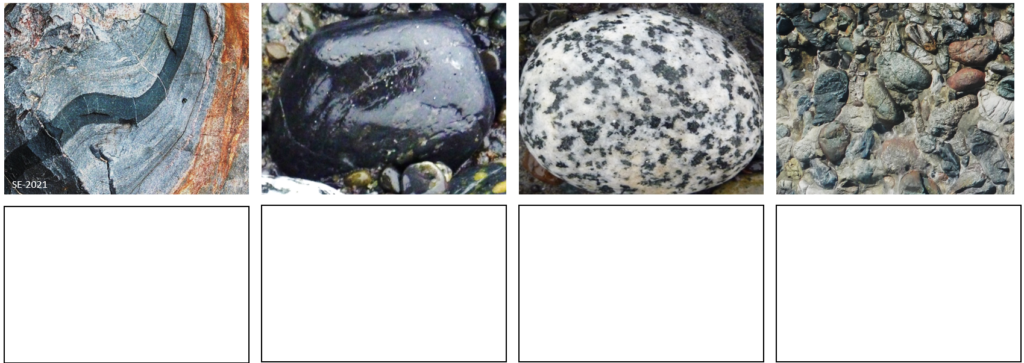2.2 Rocks
Steve Earle
Rocks are aggregates of the crystals of one or more minerals, and there are three main types: igneous, sedimentary and metamorphic. They form in different ways and they have specific properties that help us to distinguish them. Through geological processes the rocks on Earth can be transformed from one type to another, and this concept is illustrated using the rock cycle (Figure 2.2.1). The three types of rock are depicted within rectangles, some of the intermediate forms of rocky materials (magma, outcrop and loose sediments) are shown as ellipses, and the processes that are important in the transformations are shown as arrows. Those processes (solid black arrows) include:
- Uplift (such as mountain formation) that results in rock that was present at depth in the crust being brought to surface and exposed to weathering,
- Erosion and transportation of weathered products (e.g., sand, clay, and ions in solution) and then deposition as sediments (e.g., within rivers or the ocean),
- Burial of those sediments beneath other sediments, followed by compaction (squeezing) and cementation to make sedimentary rock,
- Further burial which results in heating and more squeezing and then mineral transformations to form metamorphic rock,
- Further heating or other changes in conditions that result in melting to form magma, and
- Movement of magma towards surface where it can cool slowly to make intrusive igneous rock, or to surface where it can cool quickly to make extrusive igneous (volcanic) rock.
The rock cycle can be disrupted at any point by a change in conditions brought about by uplift, or burial (dashed blue and red arrows), or in rare cases by the nearby presence of magma.

Igneous Rocks
Igneous rocks form from the cooling of magma (molten rock), either slowly at depth in the crust, or quickly at surface. In general, the longer that cooling process takes (up to millions of years), the larger the crystals will be. Volcanic rocks typically have mineral crystals that are less than 0.1 mm across (because they can cool in seconds or minutes), while intrusive igneous rocks have crystals that are typically larger than 1 mm across. Classification of igneous rocks is based mainly on the rock composition and also on the texture, and this is illustrated in Figure 2.2.2.

Three broad compositional classes of igneous rocks are shown, namely felsic, intermediate and mafic, and these are determined by the proportions of the dark silicate minerals (biotite, amphibole, pyroxene and olivine). Felsic rocks are light coloured, often close to white, with less than 20% dark minerals. Intermediate rocks are medium-dark (typically grey) with 20 to 50% dark minerals, and mafic rocks are close to black (with more than 50% dark minerals). The three main types of intrusive igneous rocks are granite, diorite and gabbro. The equivalent volcanic rocks—which are fine grained—are rhyolite, andesite and basalt. Igneous rocks with close to 100% dark minerals (not shown on Figure 2.2.2) are known as ultramafic; these are rare on the Earth’s surface, but common in the mantle.
Mafic igneous rocks (e.g., basalt or gabbro) are denser than felsic igneous rocks. Basalt has a specific gravity of about 3 g/cm3, while for granite the value is about 2.6 g/cm3. This small difference becomes very important in the context of plate tectonics. In comparison, the ultramafic rock of the mantle has a density of about 3.3 g/cm3.
Sedimentary Rocks
Sedimentary rocks form near to the Earth’s surface following the accumulation of fragments of rocks and minerals that have been weathered and eroded from outcrops, transported by gravity, rivers, waves, wind, or glacial ice, and then deposited as sediments (Figure 2.2.3). The sedimentary grains (e.g., grains of sand) are known as clasts, and the resulting sedimentary rocks are called clastic if they are composed mostly of such grains.

Clasts can range in size from tiny (invisible) clay fragments to boulders the size of buildings and we classify clastic sedimentary rocks on the basis of the clast sizes. The key piece of information to remember is that a grain of sand ranges in size from 1/16th mm to 2 mm, and that means from about 1/4 the size of the period at the end of this sentence, to about the size of this capital O. (That depends, of course, on the type of device that you are reading this on.) Very fine sand will feel gritty (not slippery) between your fingertips. Clasts smaller than 1/16th mm are classed as silt and clay, and those larger than 2 mm are granules, pebbles, cobbles and boulders (in order of increasing size). Sand grains can be transported by rivers with medium flow, by strong winds, and by waves, and so sand deposits tend to accumulate in rivers and deserts and on beaches. Silt and clay can be transported in similar environments, but they tend not to be deposited unless the medium slows, so they will be deposited in lakes, and the ocean. Granules and larger fragments can typically only be transported and deposited by fast-flowing water, and so they are commonly deposited in high-energy parts of streams. These sediments must then become buried beneath other layers of sediments and compressed and cemented before they can become sedimentary, as illustrated on Figure 2.2.1.
The three main types of clastic sedimentary rocks are illustrated on Figure 2.2.4

Sedimentary rocks can also form from the crystallization of ions that were transported in water as dissolved ions. These are known as chemical sedimentary rocks. For example, marine organisms extract bicarbonate and calcium ions (HCO3– and Ca2+) from ocean-water to make calcite shells (CaCO3) which then accumulate on the sea floor (typically in tropical areas around reefs) to form calcite mud and sand that later gets buried and becomes limestone. Some organisms make their shells out of silica, and those can accumulate on the sea floor to make the rock chert. In some cases, minerals form from the evaporation of water in an inland sea or lake. Examples are rock salt (halite) and gypsum (which is used to make plaster board).
Metamorphic Rocks
Metamorphic rocks form when pre-existing sedimentary or igneous rocks are heated and squeezed in such a way that one or more of the minerals present becomes unstable. The result might be that crystals of those minerals are converted into different minerals or into larger crystals of the same type.
One way to understand this process is to consider the sedimentary rock mudstone, which is mostly made up to clay minerals. Clays are low-temperature minerals; they are not stable at temperatures higher than about 150⁰ C. As a clay-rich rock is heated the clay minerals tend to break down and are converted into micas. At even higher temperatures those might be converted to minerals such as quartz, feldspar and amphibole.
Most metamorphism takes place at depth in the crust in areas that have experienced mountain-building (and so crustal thickening) and where there is compression due to plate convergence. That means that the rocks get heated (because of burial) and squeezed (because of the converging plates) at the same time. New minerals that form under these conditions are typically forced to grow perpendicular to the direction of that pressure, and so the metamorphic rock becomes foliated–meaning that it takes on a fabric of aligned minerals or aligned bands of minerals.
Examples of foliated metamorphic rocks are shown on Figure 2.2.5. Slate forms from mudstone at relatively low metamorphic grade, as clay minerals are turned into tiny (invisible) mica crystals. The alignment of these gives slate a layered look and the tendency to split into sheets. Schist forms at higher temperatures that allow the micas to become large enough to see. The mica crystals are generally parallel to each other, but the rock doesn’t split into sheets so easily. Gneiss forms at temperatures thar are typically beyond the stability of micas, and so is characterized by minerals like quartz, amphibole and feldspar that have segregated into dark and light bands.

It is very important not to confuse foliation with bedding. The slate of Figure 2.2.5 is not splitting along pre-existing bedding planes in the parent mudstone, and the layers in the gneiss have no relationship to what bedding (if any) might have existed in the parent rock.
Some other metamorphic rocks include quartzite and marble. These form from the metamorphosis of sandstone and limestone respectively, and they tend not to be foliated even if they did form under directional squeezing. Quartzite, for example, is mostly made up of quartz crystals, and they tend not to take on a directional fabric.
Exercise 2.3 Rock Groups
For each of the rocks illustrated in Figure 2.2.6 indicate (a) the major rock type (e.g., igneous, sedimentary or metamorphic), (b) a sub-type (e.g., intrusive igneous, clastic sedimentary), (c) a rock name (e.g., sandstone, andesite), and (d) the likely geological environment and processes that led to the formation of this rock.

Exercise answers are provided Appendix 2.
